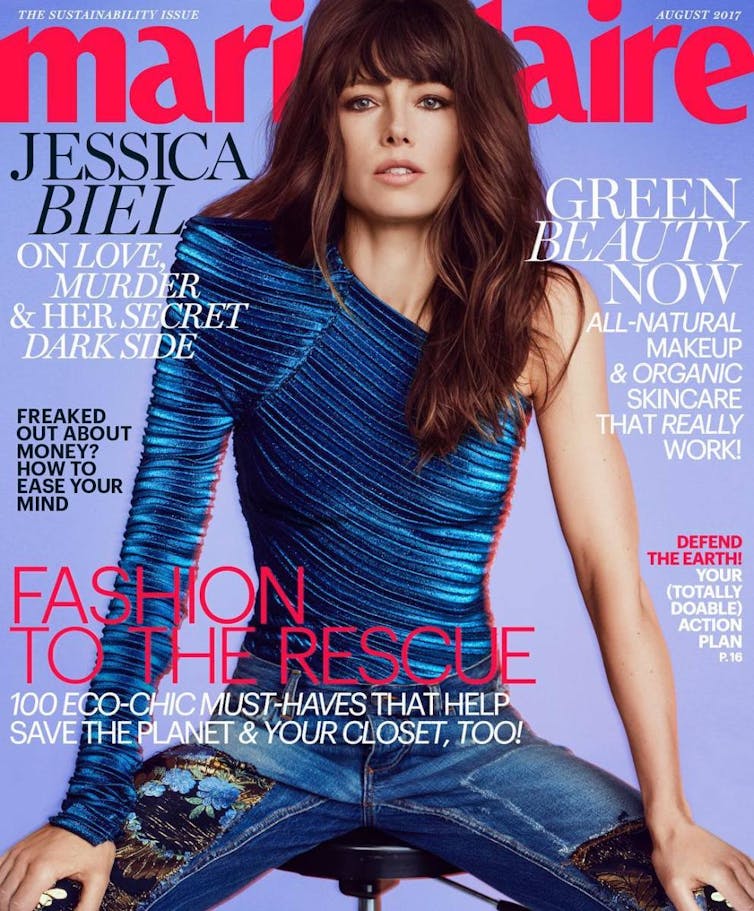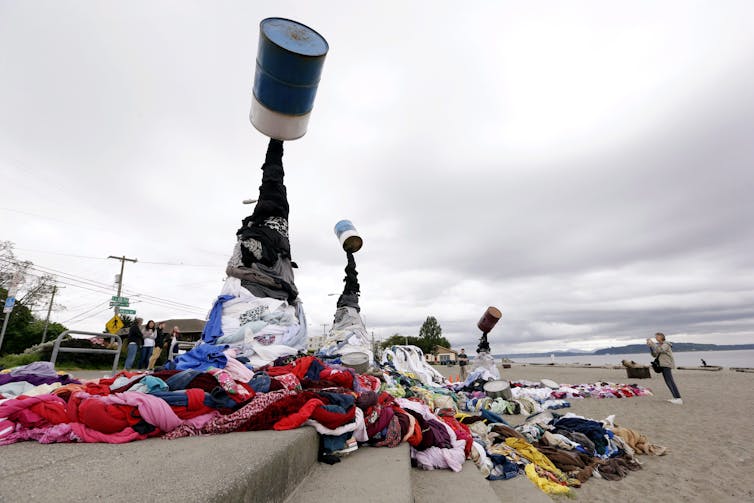 |
| Reviews and Templates for Expression We |
Your organic T-shirt is doomed to end up in a dump

British actress Emma Watson was featured in Marie Claire’s sustainability issue:
She wears only sustainable clothing on the red carpet. (AP Photo/Michel Euler)
Recently Marie Claire, a major fashion magazine, published its first ever sustainability issue. It represents one of the first times mainstream fashion turned a comprehensive and thoughtful eye on itself with regards to environmental and social issues.
Issues like climate change, sustainability, or accidents in garment factories, like the one in Bangladesh that caused the deaths of 1,110 people, get mass spotlight coverage in mainstream news media and in fashion magazines but only for a short time. During this news cycle readers are horrified about the human condition but then the issue is quickly forgotten and normalcy ensues.
However, the Aug. 2017 Marie Claire issue devoted itself fully to social and environmental concerns within the fashion industry. Historically, fashion magazines stay away from such issues. Instead, they push new trends, discuss celebrities, plug designers and push major brands — and in doing so — cater to their paid advertisers.
Yet, the current state of the fashion industry — within the context of climate change, resource depletion and other ethical concerns — must be questioned. What is the role of media and advertising in creating a necessary shift to a more sustainable fashion industry?
While Marie Claire‘s sustainability issue is a great step forward, its approach fails to question the underlying problem of over consumption.

The issue offers some basic tips like telling readers to use reusable water bottles and energy efficient lightbulbs. It also includes fascinating profiles and a section featuring sustainable fashion alternatives.
But the magazine does not feature any articles on sustainable fashion. This surface approach doesn’t make us question our current lifestyles, habits or behaviours.
The primary change we need in the fashion industry must come from consumers. Consumers need to chose a more sustainable lifestyle. We simply cannot keep consuming at the current rate and volume if we are to make effective change with regards to climate change, the environment and other pressing social issues.
Fashion’s role in climate change
If the fashion industry maintains current trajectories of production and consumption, these pressures will intensify to the point of threatening the very survival of the industry.
Successful solutions mitigating the effects of climate change, resource depletion, wildlife survival and wide-scale global pollution will require us, as a collective whole, to change how we live.
Overall apparel consumption is predicted to rise by 63 per cent by 2030: from 62 million tons today to 102 million tons according to Pulse of the Fashion Industry a recent report on the state of the industry.

To add to that, fashion industry waste created during the same time period, will increase by about 60 per cent, resulting in an additional 57 million tons of waste generated annually.
This means that within 12 years, fashion waste will total 148 million tons or 17.5kg per capita across the planet. Currently, only 20 per cent of clothing is collected for reuse or recycling with the vast majority ending up in landfills or incineration.
Technology will not save us
Marie Claire has taken the first step and brought the discussion to a mainstream publication, for a wide audience.
To involve industry experts for their special issue, Marie Claire created an advisory board comprised of socially conscious designers, the Dean at Parson’s School of Fashion and Amazon’s worldwide sustainability director. Their guest editor for the issue was Miroslava Duma, founder of Fashion Tech Lab, an accelerator and experimental laboratory to commercialise innovative technologies for the fashion industry.
One of the biggest messages in this issue promoted technology as the silver bullet solution. The idea is that technology will save us from ourselves, allowing us to retain our current lifestyles and behaviours.
Technology solutions may help but are not the only road forward, nor should we rely on them to fix the problem. For example, due to technical limitations, clothing can’t be fully recycled right now. Therefore programs touted in Marie Claire’s issue, like H&M’s “Don’t let fashion go to waste” — which encourages customers to bring their old clothing to recycling boxes in their stores — do help but are not effective solutions.
It would take 12 years for H&M to use up 1,000 tons of fashion waste, which roughly equates to the same amount the brand produces in 48 hrs. Even if clothing could be fully recycled right now, the sheer volume, poor quality and the fact that textiles are not currently made to be recycled are major problems.
A glossy can be happy and smart
The issue features interesting stories on sustainable fashion favourites like eco-chic label, Reformation and profiles on a strong line-up of eco-fashion activist women like Emma Watson, Livia Firth and meteorologist Kait Parker.
But if an organic t-shirt ends up in a landfill, it’s still a t-shirt in a landfill. It doesn’t matter how sustainable it is.
Approaches that promote “must have” sustainable options once a year in a special issue only make us feel good about consuming eco-products. They allow us to wilfully ignore the real issues.
As fashion magazines are a business, the goal is to sell as many ads as possible, as media survives on ads. Only those at the top of the fashion chain can afford to buy space in these glossy newsstand magazines. This can affect how information is presented: Advertised products must be seen in a most desirable light.
However fashion’s impact on climate change is complex and of urgent global concern. It requires everyone — including fashion magazines — to participate, if we are to find meaningful solutions.
Furthering the conversation on more sustainable lifestyles can be achieved in a positive, happy manner — in the editorial style of a glossy magazine.
Less consumption is the only way forward
The hopeful thing about Marie Claire’s attempt to introduce sustainable fashion to its readers is that sustainable fashion no longer suffers from segmentation.
Nevertheless, it needn’t be spotlighted in a special issue. Instead, fashion magazines should feature sustainable clothing every month — allowing sustainable and alternative fashion coverage within stories on large brands and retailers.
Fashion consumers should be exposed to rad eco-warriors every month. Articles could discuss issues like how to consume less with helpful tips about mending and upcycling. Editorial articles could detail what goes into creating fashion and include ideas about the future of fashion. Profiles could feature innovative start-ups.
It is time for sustainability to become part of the everyday and not a spotlight issue. Mainstream fashion media and consumers alike need to start reflecting and taking actions to collectively transition to a more sustainable society.
The August 2017 sustainability Marie Claire is beautiful and hopeful. A gorgeous Jessica Biel graces the cover, clothed in a cobalt blue jumpsuit (though not sustainable) with large red lettering across the middle: “Fashion to the rescue.” Unfortunately, perpetuation of this type of belief is dangerous. Fashion will not save us, we need to save fashion.
|
|
|
|
Copyright remains with the original authors |